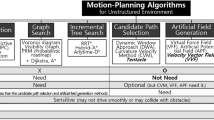Abstract
Unmanned ground vehicles (UGVs) in unstructured environments mostly operate through teleoperation. To enable stable teleoperated driving in unstructured environments, some research has suggested driver assistance and evaluation methods that involve user studies, which can be costly and require lots of time and effort. A simulation model-based approach has been proposed to complement the user study; however, the models on teleoperated driving do not account for unstructured environments. Our proposed solution involves simulation models of teleoperated driving for drivers that utilize a deep generative model. Initially, we build a teleoperated driving simulator to imitate unstructured environments based on previous research and collect driving data from drivers. Then, we design and implement the simulation models based on a conditional variational autoencoder (CVAE). Our evaluation results demonstrate that the proposed teleoperated driving model can generate data by simulating the driver appropriately in unstructured canyon terrains.
This work was supported by Agency for Defense Development Grant funded by the Korean Government (2023).
Access this chapter
Tax calculation will be finalised at checkout
Purchases are for personal use only
Similar content being viewed by others
References
Opiyo, S., Zhou, J., Mwangi, E., Kai, W., Sunusi, I.: A review on teleoperation of mobile ground robots: architecture and situation awareness. Int. J. Control Autom. Syst. 19(3), 1384–1407 (2021)
Park, K., Youn, E., Kim, S., Kim, Y., Lee, G.: Design of acceleration feedback of UGV using a stewart platform. In: 2021 21st International Conference on Control, Automation and Systems (ICCAS), pp. 79–82. IEEE (2021)
Cho, Y., Yun, H., Lee, J., Ha, A., Yun, J.: GoonDAE: denoising-based driver assistance for off-road teleoperation. IEEE Robot. Autom. Lett. 8(4), 2405–2412 (2023). https://doi.org/10.1109/LRA.2023.3250008
Storms, J., Chen, K., Tilbury, D.: A shared control method for obstacle avoidance with mobile robots and its interaction with communication delay. Int. J. Robot. Res. 36(5–7), 820–839 (2017)
Murray-Smith, R., et al.: What simulation can do for HCI research. Interactions 29(6), 48–53 (2022)
Wang, Z., et al.: Driver behavior modeling using game engine and real vehicle: a learning-based approach. IEEE Trans. Intell. Veh. 5(4), 738–749 (2020)
Li, C., Tang, Y., Zheng, Y., Jayakumar, P., Ersal, T.: Modeling human steering behavior in teleoperation of unmanned ground vehicles with varying speed. Hum. Factors 64(3), 589–600 (2022)
Schnelle, S., Wang, J., Su, H., Jagacinski, R.: A driver steering model with personalized desired path generation. IEEE Trans. Syst. Man Cybern.: Syst. 47(1), 111–120 (2016)
Murray-Smith, R., Williamson, J.H., Ramsay, A., Tonolini, F., Rogers, S., Loriette, A.: Forward and inverse models in HCI: physical simulation and deep learning for inferring 3D finger pose. arXiv preprint arXiv:2109.03366 (2021)
Sohn, K., Lee, H., Yan, X.: Learning structured output representation using deep conditional generative models. In: Advances in Neural Information Processing Systems, vol. 28 (2015)
Choe, T.S., Park, J.B., Joo, S.H., Park, Y.W.: Obstacle detection for unmanned ground vehicle on uneven and dusty environment. In: Signal Processing, Sensor/Information Fusion, and Target Recognition XXIV, vol. 9474, pp. 433–440. SPIE (2015)
Li, N., Yu, X., Liu, X., Lu, C., Liang, Z., Su, B.: 3D-lidar based negative obstacle detection in unstructured environment. In: Proceedings of the 2020 4th International Conference on Vision, Image and Signal Processing, pp. 1–6 (2020)
Naranjo, J.E., González, C., García, R., De Pedro, T.: Cooperative throttle and brake fuzzy control for ACC \(+ \) stop &go maneuvers. IEEE Trans. Veh. Technol. 56(4), 1623–1630 (2007)
Moon, H.S., Oulasvirta, A., Lee, B.: Amortized inference with user simulations. In: Proceedings of the 2023 CHI Conference on Human Factors in Computing Systems, pp. 1–20 (2023)
Knappe, G., Keinath, A., Bengler, K., Meinecke, C.: Driving simulator as an evaluation tool-assessment of the influence of field of view and secondary tasks on lane keeping and steering performance. In: 20th International Technical Conference on the Enhanced Safety of Vehicles (ESV) National Highway Traffic Safety Administration. No. 07-0262 (2007)
Knapper, A., Christoph, M., Hagenzieker, M., Brookhuis, K.: Comparing a driving simulator to the real road regarding distracted driving speed. Eur. J. Transp. Infrastruct. Res. 15(2), 205–225 (2015)
Neumeier, S., Wintersberger, P., Frison, A.K., Becher, A., Facchi, C., Riener, A.: Teleoperation: The holy grail to solve problems of automated driving? Sure, but latency matters. In: Proceedings of the 11th International Conference on Automotive User Interfaces and Interactive Vehicular Applications, pp. 186–197 (2019)
Author information
Authors and Affiliations
Corresponding author
Editor information
Editors and Affiliations
Rights and permissions
Copyright information
© 2023 The Author(s), under exclusive license to Springer Nature Switzerland AG
About this paper
Cite this paper
Yun, H., Cho, Y., Lee, J., Ha, A., Yun, J. (2023). Generative Model-Based Simulation of Driver Behavior When Using Control Input Interface for Teleoperated Driving in Unstructured Canyon Terrains. In: Iida, F., Maiolino, P., Abdulali, A., Wang, M. (eds) Towards Autonomous Robotic Systems. TAROS 2023. Lecture Notes in Computer Science(), vol 14136. Springer, Cham. https://doi.org/10.1007/978-3-031-43360-3_39
Download citation
DOI: https://doi.org/10.1007/978-3-031-43360-3_39
Published:
Publisher Name: Springer, Cham
Print ISBN: 978-3-031-43359-7
Online ISBN: 978-3-031-43360-3
eBook Packages: Computer ScienceComputer Science (R0)




